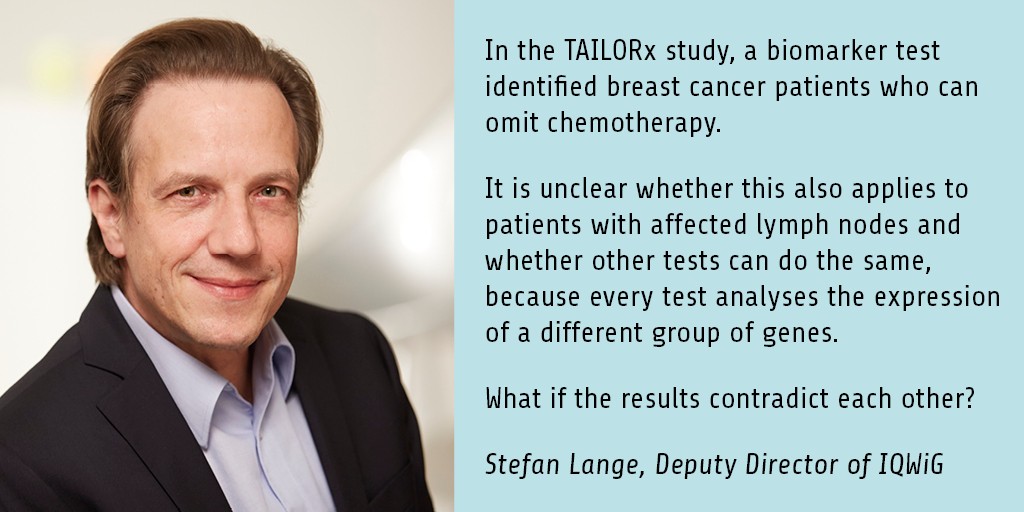Sep 5, 2018
Biomarker tests in breast cancer: New study data indicate advantage for certain patients
TAILORx: first study with sufficient observation period for the benefit assessment
The German Institute for Quality and Efficiency in Health Care (IQWiG) reinvestigated the benefit of biomarker tests to support the decision for or against adjuvant systemic chemotherapy in certain breast cancer patients, that is, women with primary hormone receptor-positive, HER2/neu-negative breast cancer and 0 to 3 affected lymph nodes.
When the Institute presented its final report on this question at the end of 2016, the evidence was inadequate to assess the benefit of such tests. The only usable data at that time were from the MINDACT study, which investigated the effects of omitting chemotherapy based on favourable MammaPrint test results in the first five years. Since important results of the large TAILORx study were published in spring 2018, the Federal Joint Committee (G-BA) commissioned IQWiG to assess these results in an addendum to the final report.
IQWiG concluded that the Oncotype DX test can identify women who can omit chemotherapy. However, only women without affected lymph nodes participated in the study. It is unclear whether women with affected lymph nodes also benefit from this test. It is also uncertain whether the clinical risk assessment, which was surprisingly unreliable in the TAILORx study, was in line with everyday health care in Germany. In addition, the results do not apply to a biomarker-based decision strategy in general because only one test was used in the study.
Not all tests are alike
The available biomarker tests aim to assess whether a woman would develop recurrences if she omitted chemotherapy in addition to hormonal therapy, i.e. if her breast cancer would return. Each test analyses the expression of a different group of genes.
It is therefore possible that some tests are better at predicting the risk of recurrence than a clinician, who looks at factors such as tumour size and type of tumour tissue, whereas other tests are not. Therefore, the result of IQWiG’s assessment – a hint of an added benefit – cannot be simply transferred to other biomarker tests.
Age makes a difference
One of the questions investigated by the TAILORx study was whether, in women with intermediate Oncotype risk score (11 to 25), recurrences were notably more frequent without additional chemotherapy than with chemotherapy. For all participants overall, there were no statistically significant differences. The women’s age apparently made a difference, however: For patients over 50 years of age or after menopause, the number of recurrences was about the same with and without chemotherapy; hence this group benefited from a test-based decision against chemotherapy. In participants under 50 years of age or before menopause, in contrast, chemotherapy had significant advantages.
Women with risk scores below 11 and above 25 were not randomized in the study. Instead, participants with low scores were not to receive chemotherapy, whereas participants with high risk scores were to receive this kind of treatment. However, plausible assumptions can be made on the basis of further study data and analyses of subgroups with the values of 11 to 15, 16 to 20, and 21 to 25. According to these assumptions, older women with risk scores between 0 and 25, and younger women with risk scores between 0 and 10 without affected lymph nodes can omit chemotherapy without notably increasing their risk of recurrence. Naturally, women for whom the decision for or against chemotherapy is already clear based on other factors are exempt from this recommendation.
Clinical risk assessment notably unreliable
Stefan Lange, IQWiG’s Deputy Director, notes: “A comparison with the other studies reveals two things. First, the disease event rates of about 15 to 17 per cent were substantially higher than in the MINDACT study, for example. This means that notably more women had recurrences. In principle, this could be expected as the observation period of up to nine years was longer than in the study data available so far. We had noted in the final report that it is rather common for breast cancer to return only after many years, which is why five-year data are unsuitable for reliable conclusions. However, it is still remarkable that chemotherapy did not reduce the risk of recurrence at all in older study participants.”
Second, the TAILORx data showed that the risk of recurrence determined clinically was very unreliable: The study participants with low and high risk had almost the same chance to be still disease-free at the end of the observation period. “It is possible, however, that further factors influence clinical assessment in German health care or that they are weighed differently”, says Stefan Lange. “It would be too early to now declare clinical risk assessment worthless based on a single study, and replace it with biomarker tests.”


